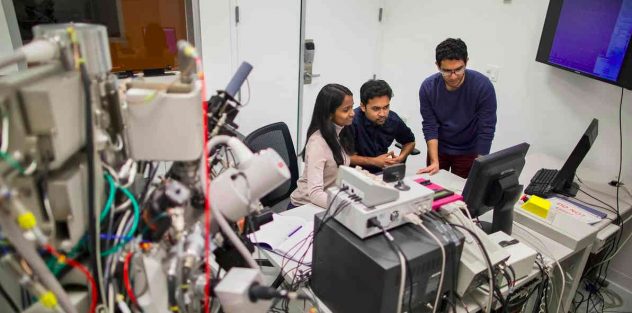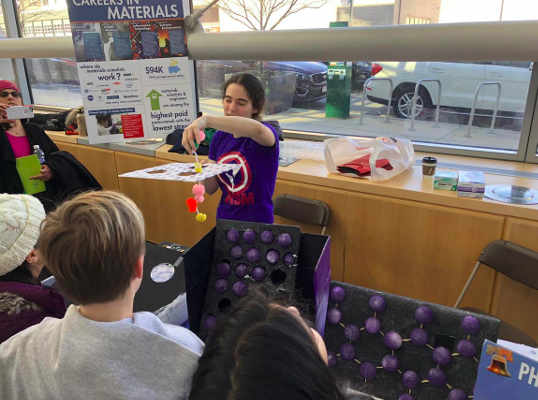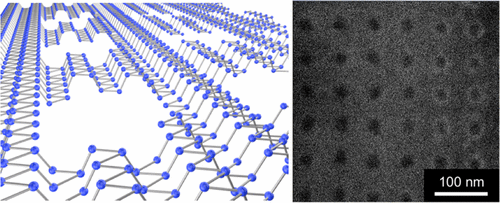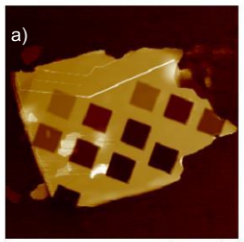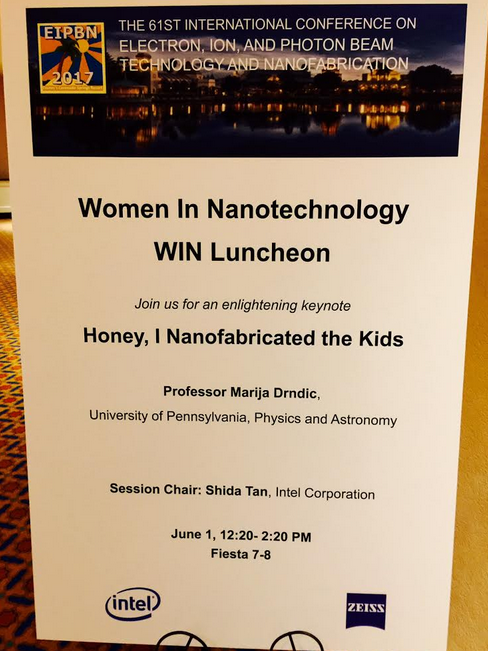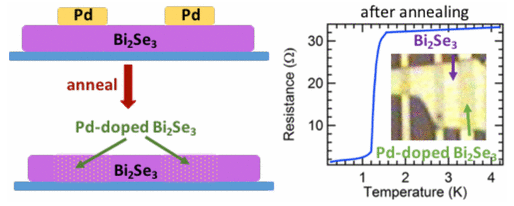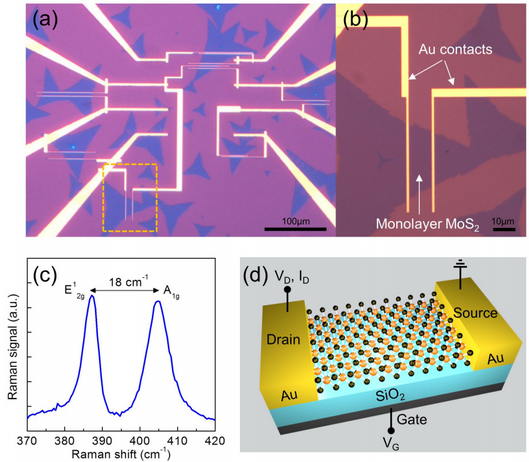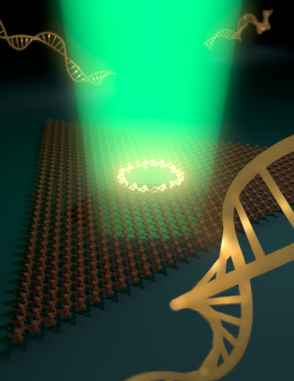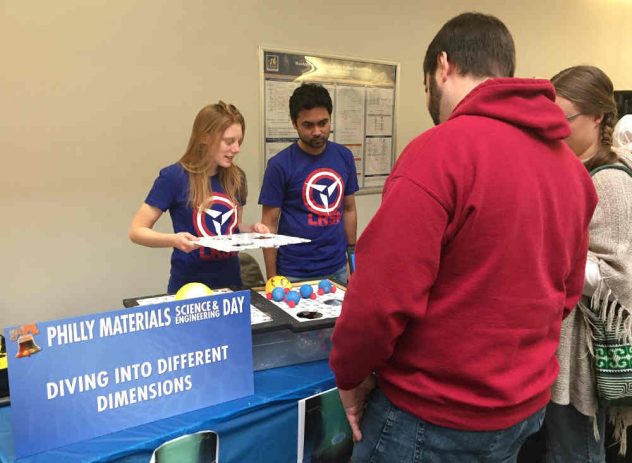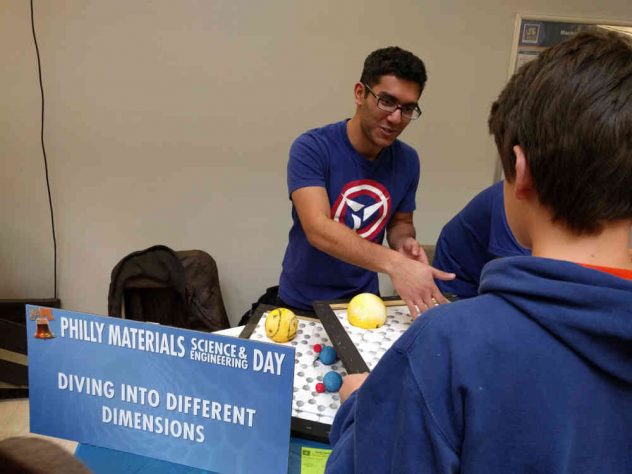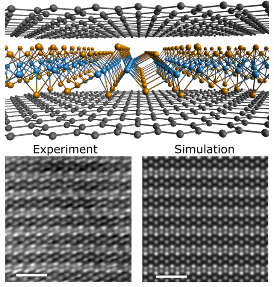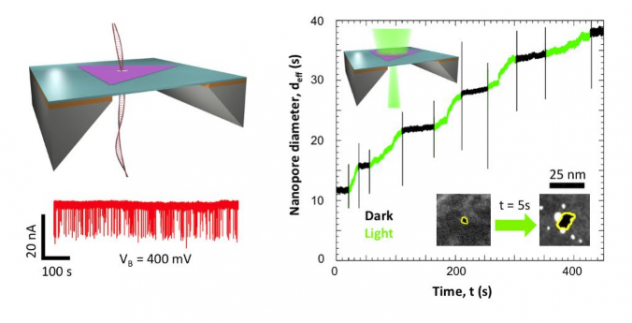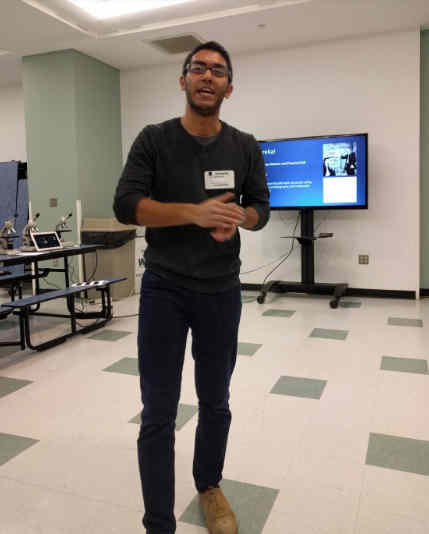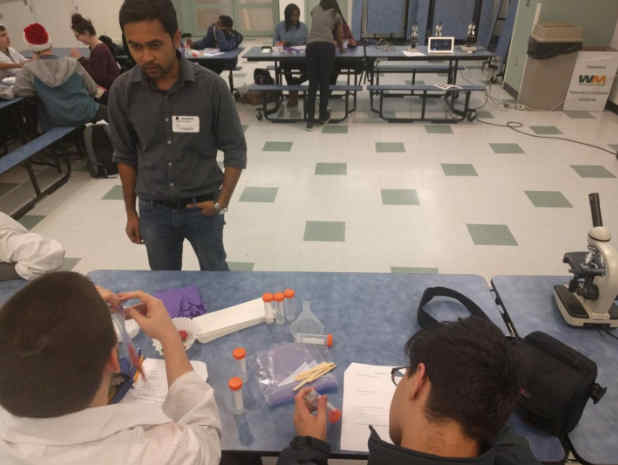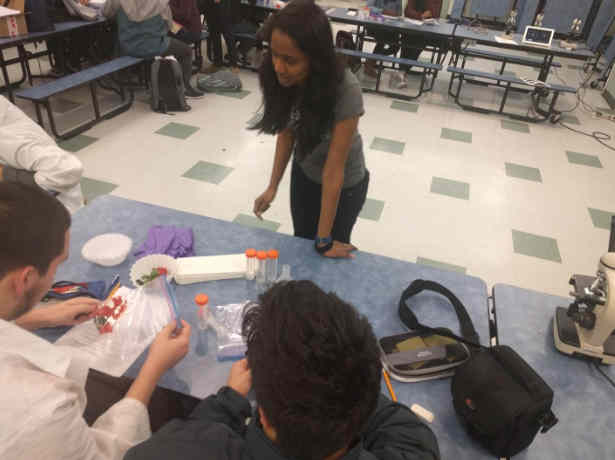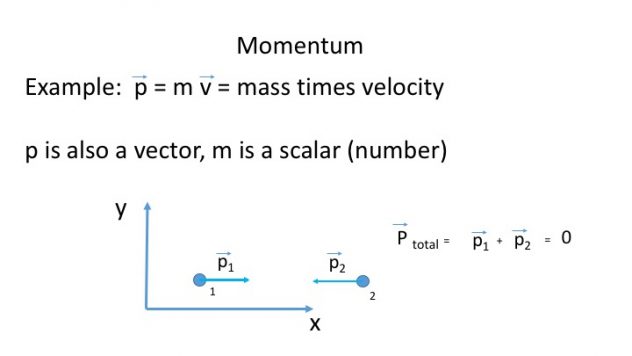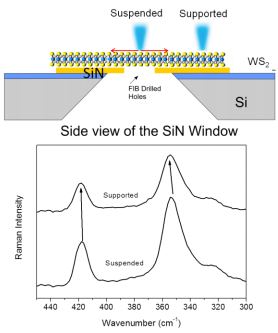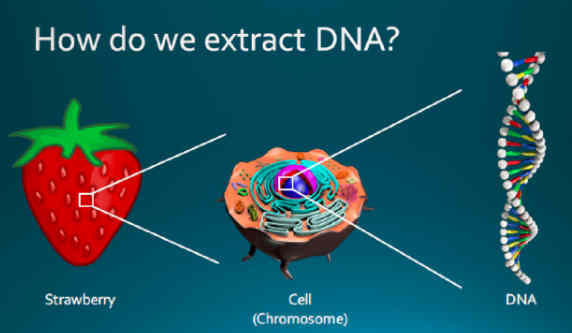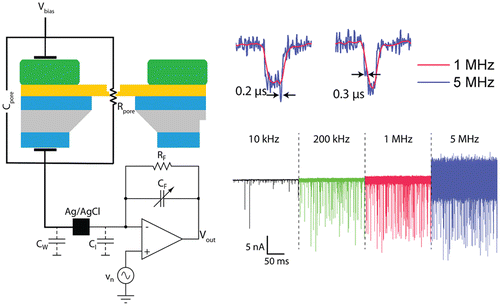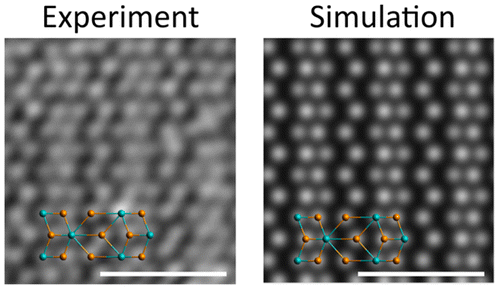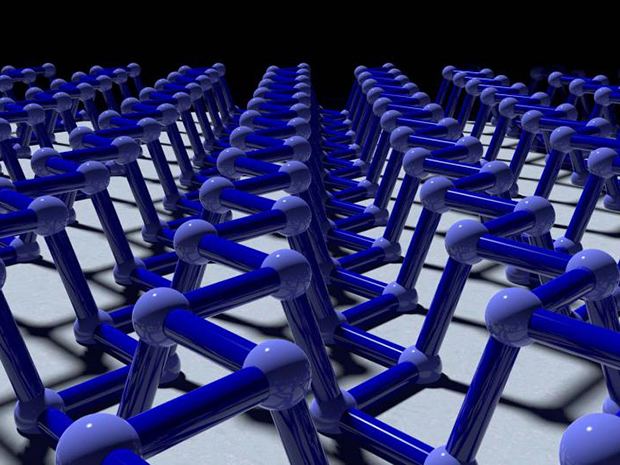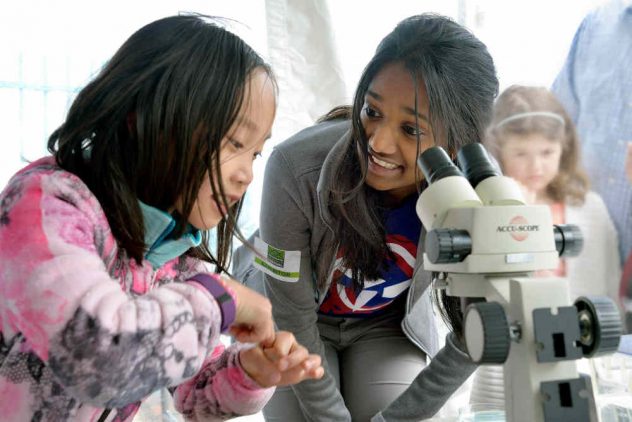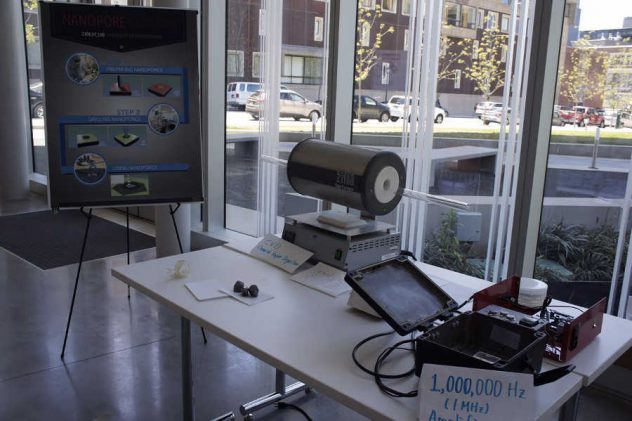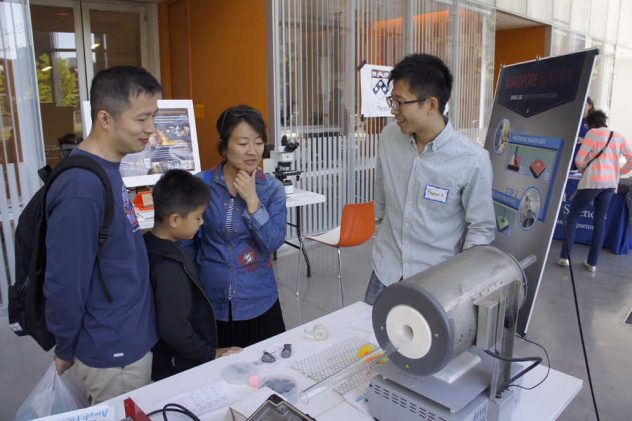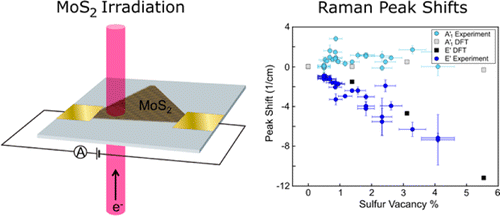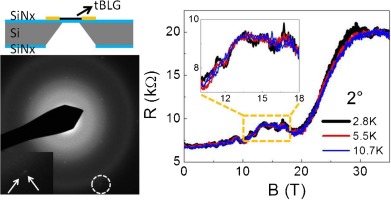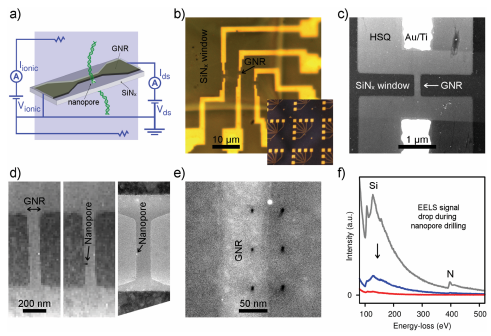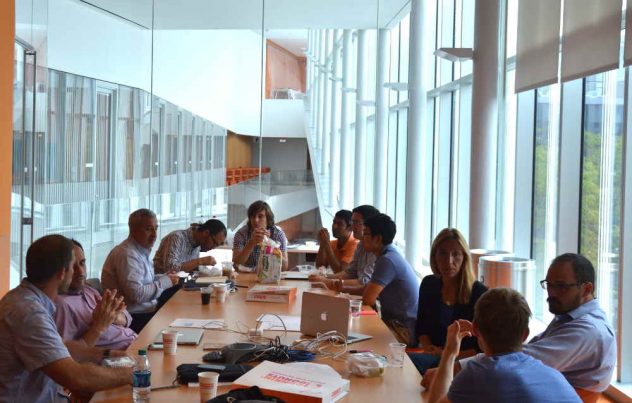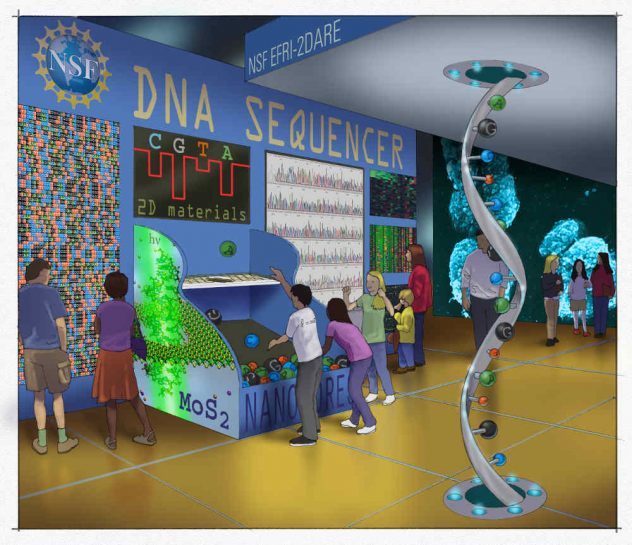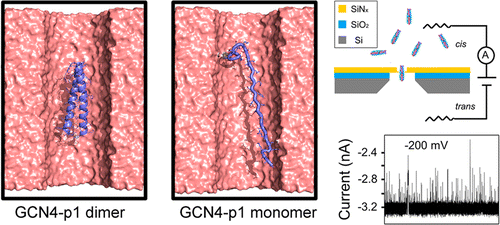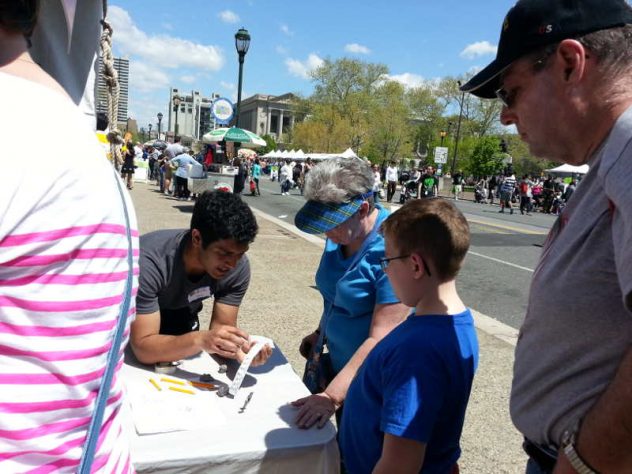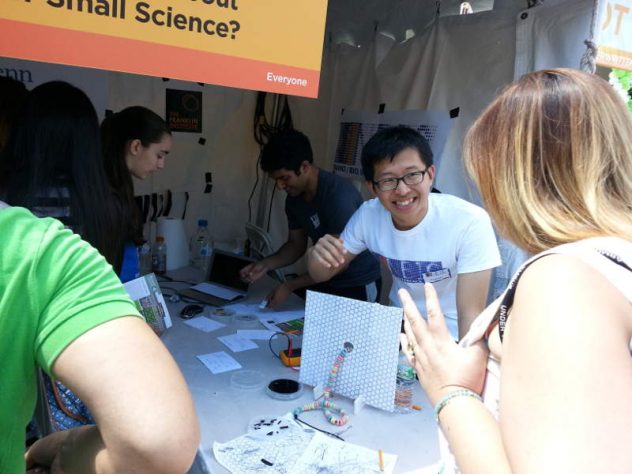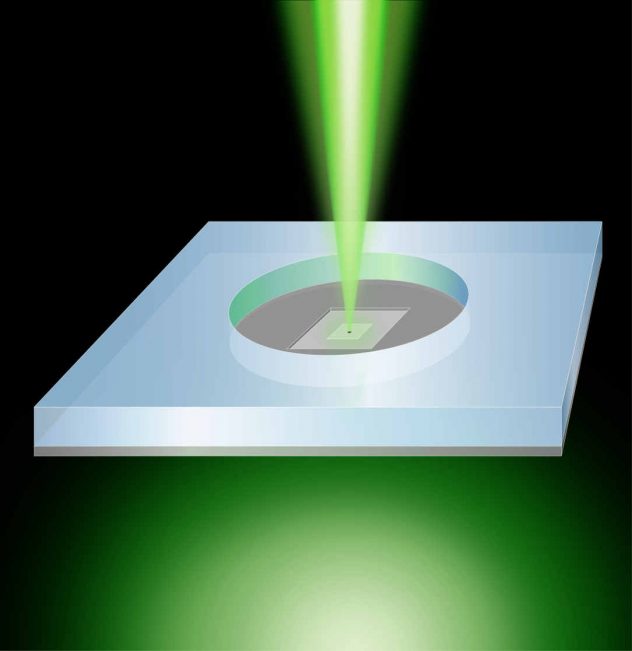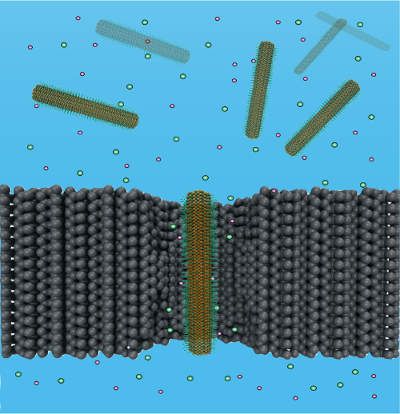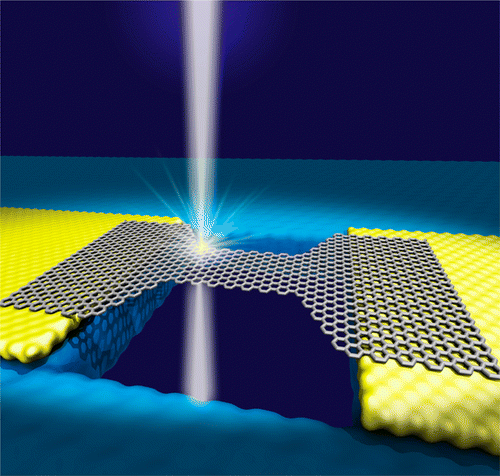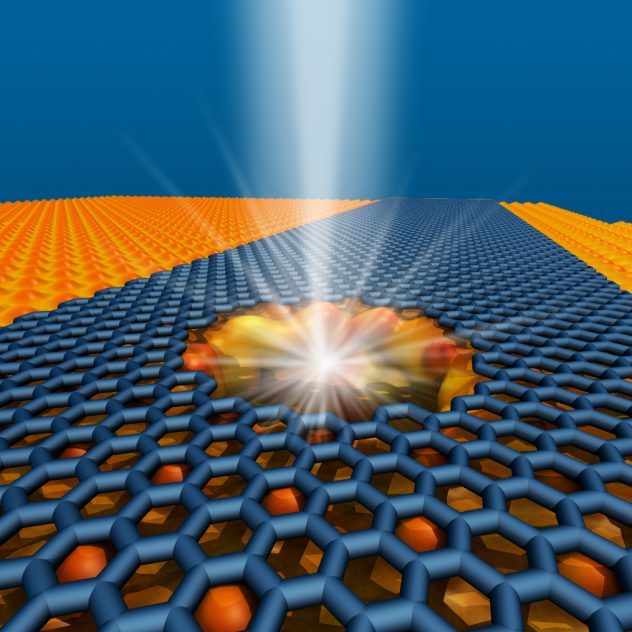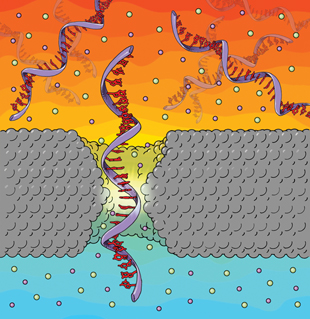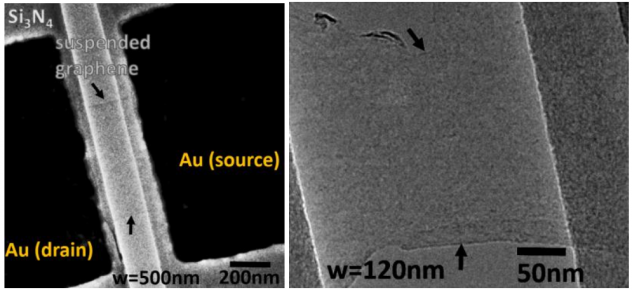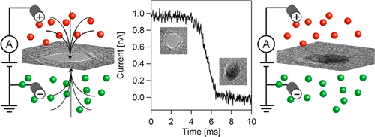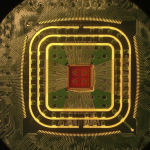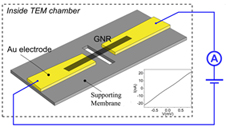- 2018/07/13
- July 13-15
- Princeton-Nature Conference: Frontiers in Electron Microscopy for the Physical and Life Sciences
- Princeton University
ICSM 2018
- 2018/07/01
- July 1 – July 6
- ICSM 2018
- Busan, Korea
KAST International workshop on Carbon Nanoelectronics
- 2018/06/30
- June 30 – July 1
- KAST International workshop on Carbon Nanoelectronics
- Busan, Korea
Nanopore/Nanofluidics Workshop
- 2018/06/19
- June 19 – June 21
- Nanopore/Nanofluidics Workshop
- Cavtat, Croatia
From Solid State Physics to Biophysics
- 2018/06/16
- June 16 – June 23
- From Solid State Physics to Biophysics
- Cavtat, Croatia
NHGRI Advanced Genomic Technology Development Grantee Meeting
- 2018/05/30
- May 30 – June 1
- NHGRI Advanced Genomic Technology Development Grantee Meeting
- Boston, MA
Penn Today Spotlight
Our group’s recent work on water filtration using nanopores was highlighted in the Penn Today!
Drndić Lab 2018
Angstrom-Size Defect Creation and Ionic Transport through Pores in Single-Layer MoS2
Jothi Priyanka Thiruraman, Kazunori Fujisawa, Gopinath Danda, Paul Masih Das, Tianyi Zhang, Adam Bolotsky, Néstor Perea-López, Adrien Nicolaï, Patrick Senet, Mauricio Terrones, and Marija Drndić
Nano Letters, 18 (3), pp 1651–1659
2018
Sydney Nano Theme and Domain Seminar
- 2018/02/05
- February 5
- Sydney Nano Theme and Domain Seminar
- Sydney, Australia
Philly Materials Day
ICONN 2018 – International Conference on Nanoscience and Nanotechnology
- 2018/01/29
- January 29 – February 2
- ICONN 2018 – International Conference on Nanoscience and Nanotechnology
- Wollongong, NSW, Australia
Signal and Noise in FET-nanopore devices
William M. Parkin and Marija Drndić
ACS Sensors, 3 (2), pp 313–319
2018
Physics Department Seminar
- 2017/12/19
- December 19
- Physics Department Seminar
- University of Bourgogne, Dijon, France
IEMN (Institute of Electronics, Microelectronics and Nanotechnology) Group Seminar
- 2017/12/16
- December 16
- IEMN (Institute of Electronics, Microelectronics and Nanotechnology) Group Seminar
- Lille, France
Graphene Group Seminar, University of Manchester
- 2017/12/08
- December 8
- Graphene Group Seminar, University of Manchester
- Manchester, UK
Cambridge Graphene Centre Seminar
- 2017/12/06
- December 6
- Cambridge Graphene Centre Seminar
- Cambridge, UK
Next Generation Sequencing Technology & Applications Congress
- 2017/12/04
- December 4-5
- Next Generation Sequencing Technology & Applications Congress
- London, UK
Accelerating Research in 2D Materials and Devices
- 2017/11/13
- November 13-15
- Accelerating Research in 2D Materials and Devices
- State College, PA
US-EU 2D Workshop
- 2017/10/24
- October 23-25
- US-EU 2D Workshop
- Arlington, VA
Drndić Lab at Nano Day
Each year, the Nano/Bio Interface Center highlights nanotechnology across Penn.
High school classes, undergraduate and graduate students,
postdocs and faculty participate in exhibits, demonstrations, tours, posters and talks.
Find out more at NanoDay@Penn.
Physics Colloquium, Department of Physics, Brown University
- 2017/09/25
- September 25
- Physics Colloquium, Department of Physics, Brown University
- Providence, RI
Invited Talk, Yucomat 2017, Meeting of Materials Research Society of Serbia
- 2017/09/06
- September 4-8
- Invited Talk, Yucomat 2017, Meeting of Materials Research Society of Serbia
- Herceg Novi, Montenegro
Academic and Summer 2017 outreach by graduate students: Physics Experiments for High-School Students during the Penn Summer Science Academy
Graduate Student Sarah Friedensen ran a lab group for the Penn Summer Science Academy’s program in Experimental Physics Research in which explored a range of topics (standing waves on violin strings, Chaldni plates, and approximate spheres (water balloons) using a high-speed camera to film each experiment, as well as a strobe light for the water balloon).
Sarah and the high school students also used the high-speed camera to film collisions between two-by-fours, objects hitting both water and ooblek, and the bursting of the water balloon and a balloon filled with ooblek.
Sarah helped guide the group with respect to what was achievable in the time frame of one week, and the students worked together to develop the specific phenomena they wanted to investigate (the group theme was “film analysis”).
The students ranged from sophomore to senior in high school and were in a group of four.
By the end of the session, through their own research, students had connected the results of their experiments to models of the hydrogen atom.
Graduate student Priyanka Thiruraman ran GEMS, a summer school program at SEAS for middle school girls, helping out with nanotechnology sessions from July 24 to July 28, 2017.
Priyanka ran two sessions on:
- DNA extraction from strawberries, where she also touched upon the concept of DNA sequencing and nanopores (our lab’s research), and
- Nanotechnology in basic physics. Experiments included polymer synthesis, non-Newtonian liquids, lasers/ optics, polarizers, kinetic sand etc. Students were also given a tour of the Singh center to see the fabrication facilities, scanning microscopes and most importantly “the microscope that occupies an entire room” aka TEM.
See the program and a video.
Graduate student Paul Masih Das was in charge until May 2017 of a volunteer group called Moelis Access Science Physics.
A team of about 10-12 undergrads and Paul would take equipment from the physics department (with the help of Bill Berner) every week and go to various public schools in West Philly (Sayre HS, West Philly HS, Comegys MS), where they performed introductory physics experiments with the students.
Paul has also given 1-2 hour outreach talks on DNA sequencing and our lab’s research in various location including the Comegys MS, Huey MS, and the Franklin Institute.
For the past two summers, Paul helped with the Franklin Institute’s Summer Camp.
A few other physics grad students and Paul went to the Franklin Institute every other week and performed an educational science activity with middle school children (building hovercrafts, learning about constellations, making circuits, etc.)
Synthesis and Physical Properties of Phase-Engineered Transition Metal Dichalcogenide Monolayer Heterostructures
Carl H. Naylor, William M. Parkin, Zhaoli Gao, Joel Berry, Songsong Zhou, Qicheng Zhang, John Brandon McClimon, Liang Z. Tan, Christopher E. Kehayias, Meng-Qiang Zhao, Ram S. Gona, Robert W. Carpick, Andrew M. Rappe, David J. Srolovitz, Marija Drndic, and Alan T. Charlie Johnson
ACS Nano, 11 (9), pp 8619–8627
2017
Invited Talk, Workshop on Nanopores
- 2017/07/16
- July 16-21
- Invited Talk, Workshop on Nanopores
- Bremen, Germany
Prof. Drndić gives lecture for high school students
Prof. Drndić gave a lecture to high school students participating at the Penn Summer Science Academy who joined Penn this summer from many different countries.
Continue reading “Prof. Drndić gives lecture for high school students”
Periodic Arrays of Phosphorene Nanopores as Antidot Lattices with Tunable Properties
Andrew Cupo, Paul Masih Das, Chen-Chi Chien, Gopinath Danda, Neerav Kharche, Damien Tristant, Marija Drndić, and Vincent Meunier
ACS Nano, 11 (7), pp 7494–7507
2017
Drndić lab in the news
Our recent work on patterning superconductivity in a topological insulator has been featured in Penn News, Phys.org, and Science Daily.
Materials analysis and focused ion beam nanofabrication of topological insulator Bi2Se3
Sarah Friedensen, Jerome T. Mlack, Marija Drndić
Scientific Reports, 7, 13466(2017)
2017
Invited Presentation at the Women In Nanofabrication (WIN), EIPBN 2017 (Electron, Ion, Photon Beam, and Nanofabrication)
- 2017/06/01
- June 1
- Invited Presentation at the Women In Nanofabrication (WIN), EIPBN 2017 (Electron, Ion, Photon Beam, and Nanofabrication)
- Orlando, FL
Five undergraduate students have recently joined our lab
The Drndić lab welcomes new undergraduate students Nikhil Chari, Abby Kaplan, Seyoung Kim, Reginald Lamaute, and Lee Blackburn.
Continue reading “Five undergraduate students have recently joined our lab”
Plenary Talk, EIPBN 2017 (Electron, Ion, Photon Beam, and Nanofabrication)
- 2017/05/30
- May 30 – June 1
- Plenary Talk, EIPBN 2017 (Electron, Ion, Photon Beam, and Nanofabrication)
- Orlando, FL
Plenary talk at EIPBN 2017
Prof. Drndić gave a plenary talk at the EIPBN 2017 entitled “2D Materials Nanosculpting in the Transmission Electron Microscope and Bioelectronics Applications” and an invited presentation at the Women in Nanofabrication (WIN) Luncheon Event at the same conference, sharing her own career path and lessons learned along the way.
Invited Talk, 3rd Annual Meeting of the Biophysical Society of Canada
- 2017/05/24
- May 24-26, 2017
- Invited Talk, 3rd Annual Meeting of the Biophysical Society of Canada
- Montreal
Patterning Superconductivity in a Topological Insulator
Jerome T. Mlack, Atikur Rahman, Gopinath Danda, Natalia Drichko, Sarah Friedensen, Marija Drndić, and Nina Marković
ACS Nano, 11 (6), pp 5873–5878
2017
Continue reading “Patterning Superconductivity in a Topological Insulator”
NIH Advanced Genomic Technology Development Grantee Meeting
- 2017/05/22
- May 22-25
- NIH Advanced Genomic Technology Development Grantee Meeting
- Boston, MA
Ambient effects on electrical characteristics of CVD-grown monolayer MoS2 field-effect transistors
Jae-Hyuk Ahn, William M. Parkin, Carl H. Naylor, A. T. Charlie Johnson, and Marija Drndić
Scientific Reports, 7, Article number: 4075
2017
Graduate Student Sarah Friedensen awarded 2017 NSF Graduate Fellowship
Congratulations to Sarah Friedensen who received the 2017 NSF Graduate Fellowship. Sarah’s work includes electronics transport in topological and two-dimensional materials in the Drndic lab. At the 2017 APS March Meeting in New Orleans she gave a talk on “Electron-beam nanosculpting and materials analysis of exfoliated bismuth selenide”.
Continue reading “Graduate Student Sarah Friedensen awarded 2017 NSF Graduate Fellowship”
Keynote Talk, International Conference on Nanopore Technology
- 2017/03/30
- March 30 – April 1
- Keynote Talk, International Conference on Nanopore Technology
- Shenzhen, China
Graphene 2017
- 2017/03/28
- March 28-31
- Graphene 2017
- Barcelona, Spain
Keynote Talk, Programmable Bio-inorganic Molecular Composites
- 2017/03/21
- March 21-22
- Keynote Talk, Programmable Bio-inorganic Molecular Composites
- Pennsylvania State University
Drndić lab alum Jessamyn Fairfield on ‘Smarter Machines’
Penn Physics alum Jessamyn Fairfield has written a feature for the March 2017 issue of Physics World about neuromorphic electronics, novel devices whose function mimics synaptic function.
Neuromorphic features can be realized in a variety of materials, from nanomaterials to polymers, and may enable the development of electronic skin, novel computational paradigms, or smart neuroprosthetics.
Jessamyn is currently a professor at NUI Galway in Ireland, and did her PhD research in the Drndic lab on semiconducting nanocrystal optoelectronics.
Full text of the article is available here: http://jessamynfairfield.com/wp-content/uploads/2017/03/PWMar17Fairfield.pdf
Continue reading “Drndić lab alum Jessamyn Fairfield on ‘Smarter Machines’”
Penn Researchers Study How New 2D Nanopores React to Light
Drndic and Johnson’s labs, together with researchers from Penn State, use light to control the size of two dimensional tungsten disulfide nanopores. Read more in the article in PennCurrent.
Continue reading “Penn Researchers Study How New 2D Nanopores React to Light”
American Physical Society Meeting
- 2017/03/13
- March 13-17
- American Physical Society Meeting
- New Orleans, LA
Colloquium, Department of Physics, University of Ottawa
- 2017/02/23
- February 23
- Colloquium, Department of Physics, University of Ottawa
- University of Ottawa
61st Annual Biophysical Society Meeting
- 2017/02/11
- February 11-15
- 61st Annual Biophysical Society Meeting
- New Orleans, LA
Drndić lab in the news
Our recent work on growth of monolayer WTe2 was featured in Penn News and Materials Today.
Drndic Lab at Philly Materials Day
At this year’s Philly Materials Day hosted by Drexel University, the lab showcased a variety of demos to the general public.
Students and parents alike were first shown the process of isolating thin 2D materials such as graphene via mechanical exfoliation.
They were then able to see the principles behind 2D-material-based water desalination using interactive large-scale models of filtration devices.
Large-area synthesis of high-quality monolayer 1T’-WTe2 flakes
Carl H Naylor, William M Parkin, Zhaoli Gao, Hojin Kang, Mehmet Noyan, Robert B Wexler, Liang Z Tan, Youngkuk Kim, Christopher E Kehayias, Frank Streller, Yu Ren Zhou, Robert Carpick, Zhengtang Luo, Yung Woo Park, Andrew M Rappe, Marija Drndić, James M Kikkawa and A T Charlie Johnson
2D Materials, 4 021008
2017
Continue reading “Large-area synthesis of high-quality monolayer 1T’-WTe2 flakes”
Monolayer WS2 Nanopores for DNA Translocation with Light-Adjustable Sizes
Gopinath Danda, Paul Masih Das, Yung-Chien Chou, Jerome T. Mlack, William M. Parkin, Carl H. Naylor, Kazunori Fujisawa, Tianyi Zhang, Laura Beth Fulton, Mauricio Terrones, Alan T. Charlie Johnson, and Marija Drndic
ACS Nano, 11 (2), pp 1937–1945
2017
Continue reading “Monolayer WS2 Nanopores for DNA Translocation with Light-Adjustable Sizes”
Transfer of Monolayer TMD WS2 and Raman Study of Substrate Effects
J.T. Mlack, P. Masih Das, G. Danda, Y.-C. Chou, C.H. Naylor, Z. Lin, N. Perea-López, T. Zhang, M. Terrones, A.T.C. Johnson, and M. Drndić
Scientific Reports, 7, Article number: 43037
2017
Continue reading “Transfer of Monolayer TMD WS2 and Raman Study of Substrate Effects”
Early Access to Graduate Research Workshop
Graduate students Paul Masih Das, Francis Chien, Jothi Priyanka Thiruraman, and Gopinath Danda participated in the Early Access to Graduate Research workshop series at the nearby Franklin Institute.
They spent the afternoon teaching high school students from the Science Leadership Academy about the history, structure, and function of DNA.
The students also learned about various 2D materials and how they can be used in nanopore DNA sequencing.
Continue reading “Early Access to Graduate Research Workshop”
Physics at Masterman Middle and High School
Prof. Drndic gave a physics talk to about two hundred curious fifth graders in the Masterman Middle & High School. She talked about subfields of physics, how to become a physicists, and covered topics in kinematics (mass, velocity, force, energy, work) as well as example of motion in two dimensions, pendula, motion in two dimensions, momentum, collisions, motion on the inclined plane, as well as explained the origin behind gravitational acceleration. She also showed mechanics demos.
Continue reading “Physics at Masterman Middle and High School”
Seminar, Department of Physics
- 2016/12/13
- December 13
- Seminar, Department of Physics
- University of Delaware
NSF EFRI Meeting
- 2016/12/08
- December 8-9
- NSF EFRI Meeting
- San Francisco, CA
2D materials advances: from large scale synthesis and controlled heterostructures to improved characterization techniques, defects and applications
Zhong Lin, Amber McCreary, Natalie Briggs, Shruti Subramanian, Kehao Zhang, Yifan Sun, Xufan Li, Nicholas J Borys, Hongtao Yuan, Susan K Fullerton-Shirey, Alexey Chernikov, Hui Zhao, Stephen McDonnell, Aaron M Lindenberg, Kai Xiao, Brian J LeRoy, Marija Drndić, James C M Hwang, Jiwoong Park, Manish Chhowalla, Raymond E Schaak, Ali Javey, Mark C Hersam, Joshua Robinson, and Mauricio Terrones
2D Materials, 3
2016
Outreach talk : Science and Comedy: Creativity in Public Engagement
Tue 12/6/2016 2-3pm Singh 221
Jessamyn Fairfield, NUI Galway, Hosted by Prof. Marija Drndic
Jessamyn organized creative and effective education and public engagement initiatives for the AMBER materials research centre at Trinity College Dublin.
Her most successful project has been the development of Bright Club Dublin, a monthly research/comedy variety night featuring academics alongside comedians in a night of idea-driven entertainment.
Jessamyn is also a frequent contributor to Futureproof, the Newstalk science show.
Continue reading “Outreach talk : Science and Comedy: Creativity in Public Engagement”
Science Talk: Nanomaterials for Neuromorphic Devices
Mon, 12/5/2016 12-1pm Singh035
Jessamyn Fairfield, NUI Galway, Hosted by Marija Drndic
Imagine a world where materials can heal themselves and electronics are built to learn the way your brain does, all using wires tinier than a human hair.
My research lab at NUI Galway is focused on taking that world from science fiction to science fact!
We take materials that are very small, or nanoscale, in one dimension, spray them onto a variety of surfaces, and try to make circuitry from them.
Networks of nanowires are memristive, which means that their electronic behavior depends on their measurement history.
We use metal nanowires that can be sprayed onto a variety of surfaces to create random networks.
Light or electricity can change these networks of nanowires in useful ways.
Where two nanowires cross to form a junction, light or electricity can change the strength of the junction.
These individual changes change the overall behaviour of the network.
The changes are self-healing, so electrical currents can route around damaged sections of network.
The network also becomes ‘smarter’ controlled changes create new meaningful patterns of response to particular complex stimuli.
When they are built, traditional silicon architectures for computing have fixed structure and implicit fixed digital modes of computation.
Nanowire networks can create flexible computational modes that can adapt on the fly, which makes nanowire networks more like brains than like silicon chips.
*light lunch will be provided
Continue reading “Science Talk: Nanomaterials for Neuromorphic Devices”
CNST Nanotechnology Seminar, National Institute of Standards and Technology (NIST)
- 2016/11/22
- November 22
- CNST Nanotechnology Seminar, National Institute of Standards and Technology (NIST)
- Gaithersburg, MD
Physics Colloquium, Case Western Reserve University
- 2016/11/10
- November 10
- Physics Colloquium, Case Western Reserve University
- Cleveland, OH
Center for Excellence for Nanostructured Graphene
- 2016/11/08
- November 8-9
- Center for Excellence for Nanostructured Graphene
- Denmark
Condensed matter seminar, Penn State University
- 2016/10/25
- October 25
- Condensed matter seminar, Penn State University
- State College, Pennsylvania
University of Biielefeld
- 2016/10/21
- October 21
- University of Biielefeld
- Bielefeld, Germany
Engineering and Life, Hanover, Germany
- 2016/10/19
- October 19-21
- Engineering and Life, Hanover, Germany
- Hanover, Germany
EU-US Workshop on 2D Materials, Heterostructures and Devices
- 2016/10/10
- October 10-12
- EU-US Workshop on 2D Materials, Heterostructures and Devices
- Manchester, UK
Prof. Drndic featured in the ACS Nano Podcast
Marija Drndic discussed the in situ transmission electron microscopy modulation of transport in graphene nanoribbons. Hear this in Episode 105 of the ACS Nano Podcast.
You can find the group’s paper, In Situ Transmission Electron Microscopy Modulation of Transport in Graphene Nanoribbons, in ACS Nano.
Continue reading “Prof. Drndic featured in the ACS Nano Podcast”
Greta Pifat Mrzljak International School of Biophysics
- 2016/09/01
- September 1-10
- Greta Pifat Mrzljak International School of Biophysics
- Croatia
Temperature- and power-dependent phonon properties of suspended continuous WS2 monolayer films
A.G. Vieira, C. Luz-Lima, G.S. Pinheiro, Zhong Lin, Julio A. Rodríguez-Manzo, N. Perea-López, A.L. Elías, Marija Drndić, M. Terrones, H. Terrones, B.C. Viana
Vibrational Spectroscopy, 86 (2016) 270–276
2016
Comegys Middle School Workshop
Graduate student Paul Masih Das gave a talk to 8th grade students at West Philadelphia’s Comegys Middle School about the ins and outs of DNA extraction and sequencing.
Afterwards, students performed a fun activity in which they extracted the DNA from strawberries using simple household products such as soap, salt, and ethanol.
Penn Summer Science Academy
This July, Prof. Drndic gave a research presentation to high school students from the Penn Summer Science Academy (PSSA).
Roughly 40 students went on a tour of our lab, in coordination with Bill Berner, where they learned about the process of fabricating and testing a solid-state nanopore.
They also learned about the wide variety of techniques and instrumentation that we use: chemical vapor deposition, photolithography, electron beam nanosculpting, and DNA translocation experiments.
More information about the Academy can be found here: http://www.physics.upenn.edu/~pssa/.
Phosphorene makes cover of ACS Nano
Our work on phosphorene
has been featured on the cover of ACS Nano, June 28, 2016 issue.
Sarah Friedensen awarded Arnold M. Denenstein Prize
This award is provided from an endowment established by the family, friends, and colleagues of Arnold M. Denenstein to honor his memory and his contributions to science. Awarded annually to a graduate student, judged by the Physics and Astronomy Department, who shows the most promise of becoming and outstanding experimental physicist.
Continue reading “Sarah Friedensen awarded Arnold M. Denenstein Prize”
Measurement of DNA Translocation Dynamics in a Solid-State Nanopore at 100 ns Temporal Resolution
Siddharth Shekar, David J. Niedzwiecki, Chen-Chi Chien, Peijie Ong , Daniel A. Fleischer, Jianxun Lin , Jacob K. Rosenstein, Marija Drndić , Kenneth L. Shepard
Nano Letters, 2016, 16 (7), pp 4483–4489
2016
Marija Drndić named Fay R. and Eugene L. Langberg Professor of Physics
Congratulations to professor Marija Drndić on being named the Fay R. and
Eugene L. Langberg Professor of Physics.
Continue reading “Marija Drndić named Fay R. and Eugene L. Langberg Professor of Physics”
From Solid-State Physics to Biophysics VIII: From Basic to Life Sciences
- 2016/06/06
- June 4-11
- From Solid-State Physics to Biophysics VIII: From Basic to Life Sciences
- Cavtat, Croatia
Monolayer single-crystal 1T’-MoTe2 grown by chemical vapor deposition exhibits a weak antilocalization effect
Carl H. Naylor, William M. Parkin, Jinglei Ping, Zhaoli Gao, Yu Ren Zhou, Youngkuk Kim, Frank Streller, Robert W Carpick, Andrew M. Rappe, Marija Drndic, James M. Kikkawa, and A.T. Charlie Johnson
Nano Letters, 2016, 16 (7), pp 4297–4304
2016
Controlled Sculpture of Black Phosphorus Nanoribbons
Paul Masih Das*, Gopinath Danda*, Andrew Cupo*, William M. Parkin, Liangbo Liang, Neerav Kharche, Xi Ling, Shengxi Huang, Mildred S. Dresselhaus, Vincent Meunier, and Marija Drndić
ACS Nano, 2016, 10 (6), pp 5687–5695
2016
This paper made the cover of the ACS Nano, June 2016 issue.
Continue reading “Controlled Sculpture of Black Phosphorus Nanoribbons”
4th annual workshop on 2D materials, "Graphene and Beyond: From Atoms to Applications"
- 2016/05/09
- May 9-10, 2016
- 4th annual workshop on 2D materials, “Graphene and Beyond: From Atoms to Applications”
- Penn State University, State College, PA
Shining a Light on Phosphorene’s Crystal Structure
Our joint research with collaborators from MIT, Tohoku University, Oak Ridge National Laboratory and Rensselaer Polytechnic Institute, published in Nano Letters, was featured in a IEEE Spectrum article.
Read the paper here and the article here.
Continue reading “Shining a Light on Phosphorene’s Crystal Structure”
EMRS Spring Meeting (Presentation by Dr. Adrian Balan)
- 2016/05/02
- May 2-6
- EMRS Spring Meeting (Presentation by Dr. Adrian Balan)
- Lille, France
NSF Graduate Research Fellowships
Graduate students Hannah Hughes received the NSF Graduate Research Fellowship and Paul Masih Das received the NSF Honorable Mention. Rebecca Engelke and Bart Machielse, who did their undergraduate research and authored several papers while in our lab, have also received the 2016 NSF Graduate Research Fellowship 2016. We wish them a great time during their PhD years at Harvard Physics, and we are looking forward to following their new scientific results!
Philly Science Festival
The Drndic group, Science Outreach Initiative of the School of Arts and Sciences, and Project BioEyes from University of Pennsylvania demonstrated how DNA affects physical features in living organisms, like zebrafish, and the importance of DNA sequencing in an educational exhibit at Philadelphia Science Festival on Saturday April 30 2016 as a part of National DNA Day initiative. Children from all age groups visited the booth, which was aptly titled “What Can Fish Tell Us About DNA?”, and learned about how a small
change in DNA sequence can create two different types of zebrafish – wildtype and albino – and how nanopore sequencing technology can help us find these differences easily.
Microscopes were installed in the booth to observe the physical differences between the two types of zebrafish larvae and adult, following which the visitor was handed an index card with a fish scale printed on one side and a colored DNA code on the other. These cards could then be inserted into punched envelopes revealing a specific color code, very similar to how nanopore DNA sequencing technology works. The color codes could be matched up to a map aiding in classification of the fish scale into the two types of fishes. A “DNA inside a nanopore” bracelet were also given to every visitor, which consisted of a colored strip of paper inside a rectangular movable sleeve with a hole in the middle.
The booth was managed by the volunteers from both the participating groups from 10 am to 4 pm at Penn’s Landing, Philadelphia. This exhibit was one of the two demonstrations which Drndic group participated in during the Philadelphia Science Festival, the other being “Nanopore Explorin’” on the previous Sunday, April 24 2016 in the Singh Nanotechnology Center, Philadelphia.
Feature in the Penn Current
Our work on in situ TEM fabrication and measurement of graphene nanoribbon transistors, In Situ Transmission Electron Microscopy Modulation of Transport in Graphene Nanoribbons by Julio A. Rodríguez-Manzo, Zhengqing John Qi, Alexander Crook, Jae-Hyuk Ahn, A. T. Charlie Johnson, and Marija Drndić, has been featured in the Penn Current.
See the news story here.
Plenary Lecture at ImPACT International Symposium on InSECT 2016: Ultrahigh-speed and multiplexed sensing system using Incredibly Smart, Efficient and Compact devices by insect Technology (InSECT)
- 2016/04/26
- April 26-27, 2016
- Plenary Lecture at ImPACT International Symposium on InSECT 2016: Ultrahigh-speed and multiplexed sensing system using Incredibly Smart, Efficient and Compact devices by insect Technology (InSECT)
- Nagoya University, Nagoya Japan
Prof. Drndic gives a plenary talk at InSECT 2016
Prof. Drndic gave a plenary talk and participated in a panel discussion at the international symposium on “Incredibly smart, efficient and compact devices by insect technology” in Nagoya, Japan on April 26-27, 2016.
Continue reading “Prof. Drndic gives a plenary talk at InSECT 2016”
Philly Science Festival
Drndić lab participate at two Philadelphia Science Festival events on April 24 and April 30, 2016.
The Drndic Lab has partnered with Dr. Slavko Milekic at Philadelphia’s University of the Arts to create two educational tools for this year’s Philadelphia Science Festival. The first “scanimation” uses an artistic technique known as persistence of vision to give the illusion of a fish swimming through an array of nanopores. The other is a cartoon-based game in which the user must guess the weight of characters in an elevator, effectively modeling nanopore DNA sequencing. Both tools are presented on portable tablet devices and suitable for a wide range of audiences.
Also, the Drndic Lab has developed a virtual nanopore app. Developed for Google Cardboard, the user can experience the actual translocation of a DNA strand through a nanopore in a stunning virtual reality environment.
Graphene 2016 (Presentation by Dr. Adrian Balan on April 21, 2016, "The effect of defects on the electrical and phonon properties of graphene and MoS2")
Presentation by Dr. Adrian Balan on April 21, 2016, “The effect of defects on the electrical and phonon properties of graphene and MoS2”
- 2016/04/21
- April 19-21
- Graphene 2016 (Presentation by Dr. Adrian Balan on April 21, 2016, “The effect of defects on the electrical and phonon properties of graphene and MoS2”)
- Genova, Italy
ACS Nano Editors’ Choice Article
Our paper “In Situ Transmission Electron Microscopy Modulation of Transport in Graphene Nanoribbons” by Julio A. Rodríguez-Manzo, Zhengqing John Qi, Alexander Crook, Jae-Hyuk Ahn, A. T. Charlie Johnson, and Marija Drndić has been chosen as the ACS Nano Editors’ Choice Article.
In Situ Transmission Electron Microscopy Modulation of Transport in Graphene Nanoribbons
Julio A. Rodríguez-Manzo, Zhengqing John Qi, Alexander Crook, Jae-Hyuk Ahn, A. T. Charlie Johnson, and Marija Drndić
ACS Nano, 2016, 10 (4), pp 4004–4010
2016
ACS Editors’ Choice Article
Marija Drndic discussed the in situ transmission electron microscopy modulation of transport in graphene nanoribbons. Hear this in Episode 105 of the ACS Nano Podcast.
Raman Shifts in Electron-Irradiated Monolayer MoS2
William M. Parkin*, Adrian Balan*, Liangbo Liang*, Paul Masih Das, Michael Lamparski, Carl H. Naylor, Julio A. Rodríguez-Manzo, A. T. Charlie Johnson, Vincent Meunier, and Marija Drndić
ACS Nano, 2016, 10 (4), pp 4134–4142
2016
Continue reading “Raman Shifts in Electron-Irradiated Monolayer MoS2”
Anisotropic Electron-Photon and Electron-Phonon Interactions in Black Phosphorus
Xi Ling, Shengxi Huang, Eddwi H. Hasdeo‡, Liangbo Liang, William M. Parkin, Yuki Tatsumi, Ahmad R. T. Nugraha, Alexander A. Puretzky, Paul Masih Das, Bobby G. Sumpter, David B. Geohegan, Jing Kong, Riichiro Saito, Marija Drndic, Vincent Meunier, and Mildred S. Dresselhaus
Nano Letters, 16 (4), pp 2260–2267
2016
Continue reading “Anisotropic Electron-Photon and Electron-Phonon Interactions in Black Phosphorus”
Jerome Mlack To Present At Aps Forum
Postdoc Jerome Mlack will be presenting at the APS U.S.-Brazil Young Physicists Forum for Early Career Physicists.
Drndic Lab at the Philadelphia Science Carnival
Graduate students Francis Chien Chen-Chi, Gopinath Danda, and Paul Masih Das are leading our group’s outreach effort at the Philadelphia Science Carnival, to be held on April 30th, 2016.
This is also part of the National DNA Day.
We are collaborating with the BioEYES, a partnership to advance K-12 science education.
We will present an integrated research exhibit spanning a range of topics related to DNA and genomics research.
We will discuss how the eye color in zebrafish is related to DNA and DNA sequencing.
We know that DNA is what genes are made up of, and that genes are responsible for the way we look and the traits we have.
Fish are an excellent animal model that allows us to visually study how the trait of dark pigmentation vs. albinism gets passed down from parents to offspring.
The title of this collaborative exhibit will be “What can a fish teach us about DNA?”
Continue reading “Drndic Lab at the Philadelphia Science Carnival”
Sarah Friedensen wins Ella N. Pawling Award
Graduate student Sarah Friedensen wins the Ella N. Pawling 2015-2016 Award.
Congratulations to Sarah Friedensen for being named the Ella N. Pawling 2015-2016 Fellow by the School of Arts and Sciences to support her academic pursuits.
Continue reading “Sarah Friedensen wins Ella N. Pawling Award”
Magnetoresistance (MR) of twisted bilayer graphene on electron transparent substrate
Sung Ju Hong, Julio A. Rodríguez-Manzo, Kyung Ho Kim, Min Park, Seung Jae Baek, Dmitry I. Kholin, Minwoo Lee, Eun Sang Choi, Dae Hong Jeong, Dawn A. Bonnell, Eugene J. Mele, Marija Drndic, A.T. Charlie Johnson, Yung Woo Park
Synthetic Metals, In Press, Corrected Proof, Available online 15 January 2016
2015
Suspended Solid-state Membranes on Glass Chips with Sub 1-pF Capacitance for Biomolecule Sensing Applications
Adrian Balan, Chen-Chi Chien, Rebecca Engelke & Marija Drndić
Scientific Reports, 5, Article number: 17775
2015
HeteroNanoCarb 2015
- 2015/12/07
- December 7-11, 2015
- HeteroNanoCarb 2015
- Benasque (Aragon), Spain
Cross-Talk Between Ionic and Nanoribbon Current Signals in Graphene Nanoribbon-Nanopore Sensors for Single-Molecule Detection
Matthew Puster, Adrian Balan, Julio A. Rodríguez-Manzo, Gopinath Danda, Jae-Hyuk Ahn, William Parkin, and Marija Drndić
Small, 2015, 11, No. 47, 6309–6316
2015
2015 APS Mid Atlantic Section Meeting
- 2015/10/23
- October 23-25, 2015
- 2015 APS Mid Atlantic Section Meeting
- Morgantown, WV
Graphene & 2D Materials Canada 2015 International Conference
- 2015/10/14
- October 14-16, 2015
- Graphene & 2D Materials Canada 2015 International Conference
- Montreal, Canada
19th Symposium on Condensed Matter Physics – SFKM 2015
- 2015/09/07
- September 7-11, 2015
- 19th Symposium on Condensed Matter Physics – SFKM 2015
- Belgrade, Serbia
EFRI Collaboration Kickoff
Led by Marija, a team with our collaborators from RPI, Rochester, Penn State and Northeastern won a 2M NSF EFRI grant. We held a kickoff meeting in August to get the ball rolling. More about the NSF grant here.
Included was a proposed portable museum exhibit to explain the concept of nanopore-based DNA sequencing, in partnership with the Franklin Museum in Philadelphia and Prof. Slavko Milekic (The University of the Arts).
Read more from PennNews.
Up and down translocation events and electric double-layer formation inside solid-state nanopores
Mehdi B. Zanjani, Rebecca E. Engelke, Jennifer R. Lukes, Vincent Meunier, and Marija Drndić
Phys. Rev. E, 92, 022715
2015
Penn Researchers Use Nanoscopic Pores to Investigate Protein Structure
The Drndić Lab was featured in PennNews. Check out the article here.
Also, see the articles from The Science Times, BioTechniques, and Parkinson’s News Today.
Continue reading “Penn Researchers Use Nanoscopic Pores to Investigate Protein Structure”
Observing Changes in the Structure and Oligomerization State of a Helical Protein Dimer Using Solid-State Nanopores
Microscopy & Microanalysis 2015
- 2015/08/02
- August 2-6, 2015
- Microscopy & Microanalysis 2015
- Portland, OR
Drug Discovery & Therapy World Congress (DDTWC) 2015
- 2015/07/22
- July 22-25, 2015
- Drug Discovery & Therapy World Congress (DDTWC) 2015
- Boston, MA
BPS Thematic Meeting "New Biological Frontiers Illuminated by Molecular Sensors and Actuators"
- 2015/06/28
- June 28 – July 1, 2015
- BPS Thematic Meeting “New Biological Frontiers Illuminated by Molecular Sensors and Actuators”
- Taipei, Taiwan
Bart Machielse Selected As MIT Summer Scholar
Undergraduate student Bart Machielse was selected as one of twelve MIT summer scholars
from June 7 to August 8, 2015. Bart was chosen among 156 applicants.
University of Pennsylania junior physics major Bartholomeus Machielse says, “I’m looking forward to meeting scientists from around the country and to experiencing the unique research environment that MIT offers, while continuing to develop the skills I’ll need to one day run my own lab.” Machielse was lead co-author of “Improving Signal-to-Noise Performance for DNA Translocation in Solid-State Nanopores at MHz Bandwidths” (Nano Letters, Nov. 21, 2014) under Prof. Marija Drndić, Professor of Physics at Penn.
Continue reading “Bart Machielse Selected As MIT Summer Scholar”
DNA Translocation in Nanometer Thick Silicon Nanopores
Julio A. Rodríguez-Manzo, Matthew Puster, Adrien Nicolaï, Vincent Meunier, and Marija Drndic
ACS Nano, 2015, 9 (6), pp 6555–6564
2015
Continue reading “DNA Translocation in Nanometer Thick Silicon Nanopores”
International Frontiers in Quantum Materials and Devices Workshop
- 2015/05/21
- May 21-22, 2015
- International Frontiers in Quantum Materials and Devices Workshop
- Harvard University, Cambridge, MA
Seminar hosted by Michael Strano’s group
- 2015/05/20
- May 20, 2015
- Seminar hosted by Michael Strano’s group
- Cambridge, MA
NHGRI Advanced Sequencing Technology Development Meeting
- 2015/05/12
- May 12-15, 2015
- NHGRI Advanced Sequencing Technology Development Meeting
- San Diego, CA
Drndić Lab attends Philadelphia Science Festival
The Drndić Lab attended the 2015 Philadelphia Science Festival, presenting nanopore demos.
Continue reading “Drndić Lab attends Philadelphia Science Festival”
Department of Physics, Applied Physics and Astronomy Colloquium
- 2015/04/22
- April 22, 2015
- Department of Physics, Applied Physics and Astronomy Colloquium
- Rensselaer Polytechnic Institute (RPI), Troy, NY
Will Parkin Receives the Arnold M. Denenstein Prize
Congratulations to Will Parkin on receiving the Arnold M. Denenstein Prize with the citation:
“For his exemplary work in combining in situ nanosculpting and aberration corrected electron microscopy of two dimensional materials.”
Continue reading “Will Parkin Receives the Arnold M. Denenstein Prize”
Selective Transport Through Nanopores: Physics Meets Biology
- 2015/03/23
- March 23-27, 2015
- Selective Transport Through Nanopores: Physics Meets Biology
- Lenzerheide, Switzerland
Congratulations to Matt Puster on defending his PhD Thesis!
Matt Puster celebrating defending his PhD Thesis.
Continue reading “Congratulations to Matt Puster on defending his PhD Thesis!”
Graphene 2015
- 2015/03/10
- March 10-13, 2015
- Graphene 2015
- Bilbao, Spain
Drndić Lab presents at APS March Meeting 2015
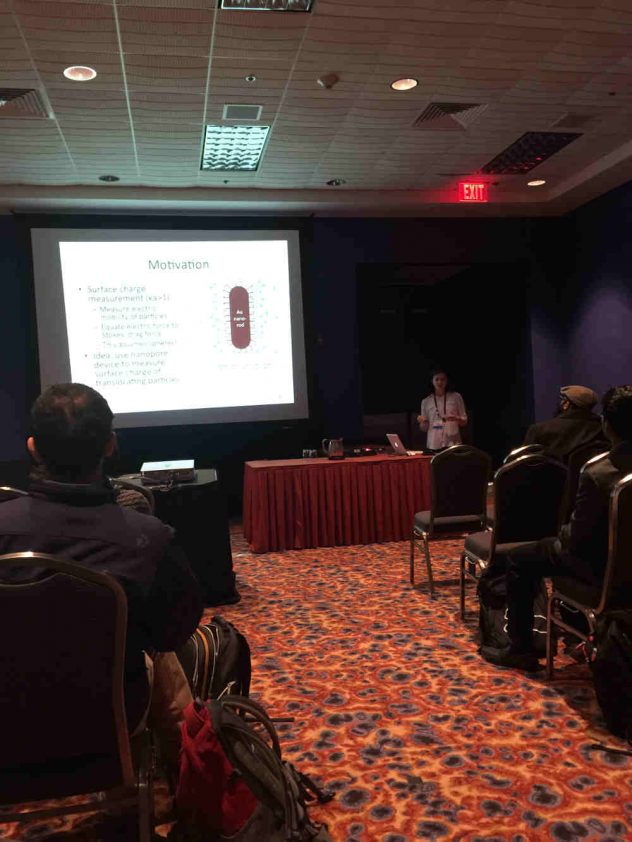
The Drndić Lab traveled to APS March Meeting 2015 in San Antonio, Texas to give the following talks:
- B1.00009 Effect of defects produced by electron irradiation on the electrical properties of graphene.
- T15.00014 Reaching the Ionic Current Detection Limit in Silicon-Based Nanopores.
- G43.00009 Improving signal-to-noise performance for DNA translocation in solid-state nanopores at MHz bandwidths.
- G43.00010 DNA translocation measurements through low-capacitance solid-state nanopore chips at high bandwidths.
- G43.00011 Up and down events in nanoparticle translocation through solid-state nanopores.
- G48.00009 Obtaining structural information of small proteins using solid-state nanopores and high-bandwidth measurements.
- T15.00003 Gold Nanorod translocations and charge measurement through solid-state nano pores.
- W47.00010 Thinning silicon-based membranes with electron irradiation for solid-state nanopore sensors.
Continue reading “Drndić Lab presents at APS March Meeting 2015”
Electronic Transport of Recrystallized Freestanding Graphene Nanoribbons
Zhengqing John Qi , Colin Daniels , Sung Ju Hong , Yung Woo Park , Vincent Meunier , Marija Drndić , and A.T. Charlie Johnson
ACS Nano, 2015, 9 (4), pp 3510–3520
2015
Continue reading “Electronic Transport of Recrystallized Freestanding Graphene Nanoribbons”
Drndić Lab at the Biophysical Society 59th Annual Meeting in Baltimore
Undergraduate student Bart Machielse presented a poster entitled “Improving signal-to-noise performance for DNA translocation in solid-state nanopores at MHz bandwidths” at the Biophysical Society 59th Annual Meeting in Baltimore, MA from February 7-11, 2015.
Continue reading “Drndić Lab at the Biophysical Society 59th Annual Meeting in Baltimore”
Drndić Lab at Philly Materials Day 2015
Paul, Gopi, Priyanka and others from Drndic Lab participate in the Philly Materials Day 2015 on February 7, 2015 in the Bossone Research Enterprise Center at Drexel University, including lots of hands-on science and engineering fun for all ages!
Paul Masih Das releases iPhone sequencing game Master Sequencer
Now available on the iTunes store!
In Master Sequencer, the player runs along a DNA strand, effectively threading it through a nanopore and allowing it to be sequenced. This model is based on nanopore DNA sequencing, in which characteristic current changes due to the presence of a DNA base-pair in a nanopore are converted into a DNA sequence. In both the game and reality, sequencing is terminated when the DNA strand crashes into the membrane. The iOS game is similar to the well-known Temple Run and appeals to a wide range of audiences.
Continue reading “Paul Masih Das releases iPhone sequencing game Master Sequencer”
Marija Drndić selected as Penn Fellow
Prof. Marija Drndić has been chosen as a Penn Fellow for the next two years. The Penn Fellows program is designed to provide a select group of developing campus leaders with an opportunity to build University-wide networks, think strategically about higher education, and learn more about Penn and its programs by interacting informally with members of the University’s executive team.
Information about the current Fellows is listed at provost.upenn.edu/penn-fellows.
18th SANKEN International Symposium and the 13th SANKEN Nanotechnology Symposium
- 2014/12/12
- December 12-14, 2014
- 18th SANKEN International Symposium and the 13th SANKEN Nanotechnology Symposium
- Osaka, Japan
Improving signal-to-noise performance for DNA translocation in solid-state nanopores at MHz bandwidths
Adrian Balan, Bartholomeus Machielse, David Niedzwiecki, Jianxun Lin, Peijie Ong, Rebecca Engelke, Kenneth Shepard, and Marija Drndić
Nano Letters, 14 (12), 7215-7220
2014
Second Annual AMC8 Math Day at Greenfield Elementary School
For the second year in a row, Marija is organizing the Greenfield Math Day in Albert Greenfield Elementary School in Center City, Philadelphia, to be held on November 18, 2014. (Any interested parents or children from other local schools interested to participate are welcome to contact Marija).
Last year, the whole middle school consisting of about 200 students participated. The AMC8 is an international competition consisting of 25 multiple-choice questions and students have 40 minutes to work on it initiated by the Mathematical Association of America (MAA). MAA encourages all students in grades 6, 7 and 8 to participate in the AMC 8. All USA, USA embassy, Canadian and foreign school students in grade 8 or below are eligible to participate. Especially talented students as young as 8 years old have participated in the past.
Continue reading “Second Annual AMC8 Math Day at Greenfield Elementary School”
Electronic Transport In Heterostructures Of Chemical Vapor Deposited Graphene And Hexagonal Boron Nitride
Zhengqing John Qi, Sung Ju Hong, Julio A. Rodríguez-Manzo, Nicholas J. Kybert, Rajatesh Gudibande, Marija Drndić, Yung Woo Park and A. T. Charlie Johnson
Small
2014
Materials Science Seminar
- 2014/10/17
- October 17, 2014
- Materials Science Seminar
- Cornell University, Ithaca, NY
Visit us at the NanoDay@Penn on October 22, 2014
Each year, the Nano/Bio Interface Center highlights nanotechnology across Penn.
High school classes, undergraduate and graduate students,
postdocs and faculty participate in exhibits, demonstrations, tours, posters and talks.
Find out more at NanoDay@Penn.

Continue reading “Visit us at the NanoDay@Penn on October 22, 2014”
Sequencing With Graphene Pores
Penn Team Studies Nanocrystals By Passing Them Through Tiny Pores
Our MRSEC IRG-4 team (Drndić, Murray and Lukes labs) studies gold nanorods by passing them through nanopores (Nano Letters, 2014).
(MRSEC = Materials Research and Engineering Center; IRG = Interdisciplinary Research Group)
See the press release
Continue reading “Penn Team Studies Nanocrystals By Passing Them Through Tiny Pores”
8th International Microscopy Conference
- 2014/09/07
- September 7-12, 2014
- 8th International Microscopy Conference
- Prague, Czech Republic
7th International Conference on Molecular Electronics
- 2014/08/24
- August 24-29, 2014
- 7th International Conference on Molecular Electronics
- Strasbourg, France
Gold Nanorod Translocations and Charge Measurement through Solid-State Nanopores
Kimberly Venta, Mehdi B Zanjani, Xingchen Ye, Gopinath Danda, Christopher B. Murray, Jennifer R. Lukes, and Marija Drndić
Nano Letters, 14 (9), 5358–5364
2014
Gordon Research Conference on Bioelectrochemistry
- 2014/07/06
- July 6-11, 2014
- Gordon Research Conference on Bioelectrochemistry
- University of New England, Maine
Correlating Atomic Structure and Transport in Suspended Graphene Nanoribbons
Zhengqing John Qi, Julio A. Rodríguez-Manzo, Andrés R. Botello-Méndez, Sung Ju Hong, Eric A. Stach, Yung Woo Park, Jean-Christophe Charlier, Marija Drndić, and A. T. Charlie Johnson
Nano Letters, 14 (8), 4238–4244
2014
The European Workshop on Epitaxial Graphene and 2D Materials (EWEG/2D 2014)
- 2014/06/15
- June 15-19, 2014
- The European Workshop on Epitaxial Graphene and 2D Materials (EWEG/2D 2014)
- Primosten, Croatia
From Solid State to BioPhysics VII: From Basic to Life Sciences
- 2014/06/07
- June 7-14, 2014
- From Solid State to BioPhysics VII: From Basic to Life Sciences
- Cavtat, Croatia
58th Annual EIPBN Conference
- 2014/05/26
- May 26-30, 2014
- 58th Annual EIPBN Conference
- Washington, DC
Graphene
- 2014/05/06
- May 6-9, 2014
- Graphene
- Toulouse, France
Philly Science Festival
Come see our work at the Philly Science Festival Carnival on May 3, 2014.
The Carnival runs from 10am to 4pm, and our group will demonstrate our work at a booth between
21st and 22nd on Benjamin Franklin Parkway.
The Philadelphia science carnival features more than 175 exhibitors offering non-stop, family-friendly experiments, interactive activities, games, and a packed line-up of live entertainment. Enjoy making slime, meeting live zoo animals, checking out the inner-workings of robots, taking a tour of a helicopter, extracting DNA from a strawberry, testing a “crime scene” for forensic evidence, and so much more!
For more information, please go to philasciencefestival.org
MRS Spring Meeting
- 2014/04/21
- April 21-25, 2014
- MRS Spring Meeting
- San Francisco, CA
Marija Drndić Named 2013 APS Fellow
Professor Marija Drndić has been named an APS Fellow “For development of novel nanofabrication methods for graphene nanoelectronics and fast biomolecular analysis in solution.”
Nominated by: Division of Condensed Matter Physics
More info at the APS Fellow Archive.
IWEPNM 2014
- 2014/03/08
- March 8-15, 2014
- IWEPNM 2014
- Krichberg, Austria
2014 APS March Meeting
- 2014/03/03
- March 3-7, 2014
- 2014 APS March Meeting
- Denver, CO
Symposium on DNA Nanotechnology, Plenary Lecture
- 2013/11/27
- November 27-29, 2013
- Symposium on DNA Nanotechnology, Plenary Lecture
- Chalmers University of Technology, Gothenburg, Sweden
Graphene Nanoribbon-Nanopore Devices for DNA Sequencing
Graphene-based nanopore devices are promising candidates for next-generation DNA sequencing. In this paper, we fabricated graphene nanoribbon-nanopore (GNR-NP) sensors for DNA detection. GNR conductance was monitored in situ during electron irradiation-induced nanopore formation inside a transmission electron microscope (TEM). We show that GNR resistance increases linearly with electron dose and that GNR conductance and mobility decrease by a factor of ten or more when GNRs are imaged at relatively high magnification with a broad beam prior to making a nanopore. By operating the TEM in scanning TEM (STEM) mode, in which the position of the converged electron beam can be controlled with high spatial precision via automated feedback, we were able to prevent electron beam-induced damage and make nanopores in highly conducting GNR sensors. This method minimizes the exposure of the GNRs to the beam before and during nanopore formation. The resulting GNRs with unchanged resistances after nanopore formation can sustain microampere currents at low voltages (around 50 mV) in buffered electrolyte solution and exhibit high sensitivity, with a large relative change of resistance upon changes of gate voltage, similar to pristine GNRs without nanopores.
Selected Press:
- Penn News: Penn Produces Graphene Nanoribbons With Nanopores for Fast DNA Sequencing
- ScienceDaily: Graphene Nanoribbons With Nanopores Created for Fast DNA Sequencing
Continue reading “Graphene Nanoribbon-Nanopore Devices for DNA Sequencing”
Toward Sensitive Graphene Nanoribbon–Nanopore Devices by Preventing Electron Beam-Induced Damage
Matthew Puster, Julio A. Rodriguez-Manzo, Adrian Balan, and Marija Drndić
ACS Nano, 7 (12), 11283–11289
2013
Continuous Growth of Hexagonal Graphene and Boron Nitride In-Plane Heterostructures by Atmospheric Pressure Chemical Vapor Deposition
Gang Hee Han , Julio A. Rodriguez-Manzo , Chan-Woo Lee , Nicholas J. Kybert , Mitchell B. Lerner , Zhengqing John Qi , Eric N. Dattoli , Andrew M. Rappe , Marija Drndić, and A.T. Charlie Johnson
ACS Nano, 7 (11), 10129–10138
2013
Crystal and Graphene Science Symposium 2013
- 2013/09/04
- September 4-5, 2013
- Crystal and Graphene Science Symposium 2013
- Boston, MA
Drndić Lab working on open-source translocation analysis software Pypore
The Drndić Lab has open-sourced the translocation analysis software Pypore.
This project is writting in a combination of Python and Cython for high-throughput nanopore data analysis. Please, fork the repo and send in your pull requests!
Continue reading “Drndić Lab working on open-source translocation analysis software Pypore”
3rd Next Generation Sequencing
- 2013/06/19
- June 19-21, 2013
- 3rd Next Generation Sequencing
- San Francisco, CA
Novel Approaches to DNA Sequencing
- 2013/06/09
- June 9-14, 2013
- Novel Approaches to DNA Sequencing
- Nordic Institute for Theoretical Physics, Stockholm, Sweden
Northeastern University Physics Colloquium
- 2013/05/23
- May 23, 2013
- Northeastern University Physics Colloquium
- Northeastern University, Boston, MA
Differentiation of DNA Homopolymers
In a recent ACS Nano paper, “Differentiation of Short, Single-Stranded DNA Homopolymers in Solid-State Nanopores”, we show that small solid-state nanopores similar in size to protein nanopores, combined with an optimized setup, can differentiate between single-stranded DNA homopolymers (with A, C, and T bases).
Selected press:
Disruptive Technologies Workshop, Genome Canada
- 2013/05/09
- May 9-10, 2013
- Disruptive Technologies Workshop, Genome Canada
- Toronto, Canada
NHGRI Advanced Sequencing Technology Development Meeting
- 2013/04/29
- April 29 – May 3, 2013
- NHGRI Advanced Sequencing Technology Development Meeting
- San Diego, CA
Differentiation of Short, Single-Stranded DNA Homopolymers in Solid-State Nanopores
Kimberly Venta*, Gabriel Shemer*, Matthew Puster, Julio A. Rodríguez-Manzo, Adrian Balan, Jacob K. Rosenstein, Ken Shepard, and Marija Drndić
ACS Nano, 7 (5), 4629-4636
2013
Direct electron beam patterning of sub-5nm monolayer graphene interconnects
APS March Meeting
- 2013/03/19
- March 19, 2013
- APS March Meeting
- Baltimore, MD
XIV Annual Linz Winter Workshop on Advances in Single-Molecule Research for Biology and Nanoscience
- 2013/02/15
- February 15-18, 2013
- XIV Annual Linz Winter Workshop on Advances in Single-Molecule Research for Biology and Nanoscience
- Linz, Austria
Electrically Controlled Nanoparticle Synthesis inside Nanopores
Kimberly E. Venta, Meni Wanunu, Marija Drndić
Nano Letters, 13 (2), 423–429
2013
Nanoscale Biophysics Symposium, Biophysical Society Meeting
- 2013/02/02
- February 2, 2013
- Nanoscale Biophysics Symposium, Biophysical Society Meeting
- Philadelphia, PA
Fabrication and characterization of nanopores with insulated transverse nanoelectrodes for DNA sensing in salt solution
19th International Symposium on Electro and Liquid Phase Separation Technologies
- 2012/09/30
- September 30 – October 3, 2012
- 19th International Symposium on Electro and Liquid Phase Separation Technologies
- Baltimore, MD
CECAM Workshop on Polymer Translocation in Nanopores
- 2012/09/16
- September 16-18, 2012
- CECAM Workshop on Polymer Translocation in Nanopores
- Mainz, Germany
Meeting on Applying Next-Generation Sequencing
- 2012/08/13
- August 13-15, 2012
- Meeting on Applying Next-Generation Sequencing
- Providence, RI
CECAM Workshop on DNA Sequencing and Detection with Nanoprobes
- 2012/06/11
- June 11-13, 2012
- CECAM Workshop on DNA Sequencing and Detection with Nanoprobes
- Pisa, Italy
Graphene Week 2012
- 2012/06/04
- June 4-8, 2012
- Graphene Week 2012
- Delft, Netherlands
University of Michigan Physics Colloquium
- 2012/05/01
- March 2012
- University of Michigan Physics Colloquium
- University of Michigan, Ann Arbor, MI
Matt Hickman Recieves 2012 Graduate Student Fellowship
Graduate student Matt Hickman received a 2012 NSF Graduate Student Fellowship.
Matt’s journey took him from high energy physics to his new passion for single molecule biophysics experiments using graphene nanopores (March 2012).
Continue reading “Matt Hickman Recieves 2012 Graduate Student Fellowship”
Integrated Nanopore Sensing Platform
Results from our collaboration with Ken Shepard’s group at Columbia University were just published in Nature Methods: “Integrated Nanopore Sensing Platform with Sub-Microsecond Temporal Resolution”.
Selected press:
Integrated nanopore sensing platform with sub-microsecond temporal resolution
Jacob K. Rosenstein, Meni Wanunu, Christopher A. Merchant, Marija Drndić, Kenneth L. Shepard
Nature Methods, 9 (5), 487-492
2012
Matt Puster Receives NSF IGERT Fellowship
Graduate student Matt Puster received the NSF-IGERT Graduate Nanotechnology Fellowship.
Continue reading “Matt Puster Receives NSF IGERT Fellowship”
Nanopores Confernce 2012
- 2012/02/02
- February 2012
- Nanopores Confernce 2012
- Lanzarote, Spain
Gene, Genomes and Pediatric Disease Seminar Series
- 2012/02/01
- February 2012
- Gene, Genomes and Pediatric Disease Seminar Series
- Children’s Hospital of Philadelphia, Philadelphia, PA
Physics and BioDesign Colloquium
- 2012/01/15
- January 2012
- Physics and BioDesign Colloquium
- Arizona State University
DNA Base-Specific Modulation of Microampere Transverse Edge Currents through a Metallic Graphene Nanoribbon with a Nanopore
International Symposium on Clusters and Nanostructures (ISCAN)
- 2011/11/15
- November 2011
- International Symposium on Clusters and Nanostructures (ISCAN)
- Richmond, VA
Nanopore Analysis of Individual RNA/Antibiotic Complexes
Meni Wanunu, Swati Bhattacharya, Yun Xie, Yitzhak Tor, Aleksei Aksimentiev, Marija Drndić
ACS Nano, 5 (12), 9345-9353
2011
In Situ Electronic Characterization of Graphene Nanoconstrictions Fabricated in a Transmission Electron Microscope
Ye Lu*, Christopher A. Merchant*, Marija Drndić, A.T. Charlie Johnson
Nano Letters, 11 (12), 5184-5188
2011
Nano Day at UPenn, Symposium on Local Probes at the Frontiers of Energy Systems and Biotechnology
- 2011/10/15
- October 2011
- Nano Day at UPenn, Symposium on Local Probes at the Frontiers of Energy Systems and Biotechnology
- University of Pennsylvania, Philadelphia, PA
Workshop on the Many Interfaces of Physics
- 2011/09/15
- September 2011
- Workshop on the Many Interfaces of Physics
- Institute of Science and Technology Austria, Vienna, Austria
Lab Receives NIH Grant
New NIH grant awarded to our lab to advance nanotechnology for DNA sequencing.
Selected press:
Meni Wanunu Starts At Northeastern University
Former post-doc Meni Wanunu started an Assistant Professor position at Northeastern University.
Continue reading “Meni Wanunu Starts At Northeastern University”
Jessamyn Fairfield Receives NSF Travel Fellowship
Graduate student Jessamyn Fairfield received an NSF travel fellowship to attend the Pan-American Advanced Studies Institute in Costa Rica on Scalable, Functional Nanomaterials.
Continue reading “Jessamyn Fairfield Receives NSF Travel Fellowship”
Chris Merchant Receives AAAS Science Policy Fellowship
Post-doc Chris Merchant received the AAAS Science Policy Fellowship.
Continue reading “Chris Merchant Receives AAAS Science Policy Fellowship”
Collective Fluorescence Enhancement In Nanoparticle Clusters
In a recent Nature Communications paper, “Collective fluorescence enhancement in nanoparticle clusters”, we show that blinking nanorods interact with each other in a cluster, and the interactions affect the blinking statistics.
Selected press:
Continue reading “Collective Fluorescence Enhancement In Nanoparticle Clusters”
Collective fluorescence enhancement in nanoparticle clusters
Siying Wang, Claudia Querner, Tali Dadosh, Catherine H. Crouch, Dmitri S. Novikov, Marija Drndić
Nature Communications, 2, 364
2011
Telluride Workshop on Single-Molecule Dynamics
- 2011/06/15
- June/July 2011
- Telluride Workshop on Single-Molecule Dynamics
- Telluride, CO
Lauren Willis Makes The Cover Of Science
Graduate student Lauren Willis used high resolution transmission electron microscopy (TEM) to image gold particles attached to peptides wrapped around individual single wall nantubes (SWNTs), which allowed quantitative analysis of particle spacing and configuration to confirm the computational model of the complex.
This paper, Computational Design of Virus-Like Protein Assemblies on Carbon Nanotube Surfaces, was selected for the cover of Science.
Computational Design of Virus-Like Protein Assemblies on Carbon Nanotube Surfaces
Computational Design of Virus-Like Protein Assemblies on Carbon Nanotube Surfaces
Gevorg Grigoryan*, Yong Ho Kim*, Rudresh Acharya, Kevin Axelrod#, Rishabh M. Jain#, Lauren Willis, Marija Drndić, James M. Kikkawa, William F. DeGrado
Science, 332 (6033), 1071-1076
2011
Partnership for Research and Education in Materials, 5th Annual Symposium
- 2011/05/15
- May 2011
- Partnership for Research and Education in Materials, 5th Annual Symposium
- Universidad de Puerto Rico en Humacao, Puerto Rico
Seeking Postdoc Applications
We are seeking postdoc applications from outstanding candidates to join our effort on the advancement of fundamental science of ion/biomolecule/nanopore systems and the development of new sequencing technologies based on nanopores in graphene-based and silicon nitride-based platforms.
Expertise in nanofabrication, electron beam lithography, transmission electron microscopy, electrical measurements with nanopores and microfluidics, biological sample preparation and handling, is a plus.
Please send your interest to Prof. Drndić at drndic@physics.upenn.edu.
Kim Venta Receives NSF Graduate Student Fellowship
Graduate student Kim Venta received an NSF Graduate Student Fellowship. Kim works at an intersection of condensed matter physics, biophysics and chemistry on understanding and developing approaches for biomolecule manipulation and analysis, including DNA sequencing, using graphene.
Continue reading “Kim Venta Receives NSF Graduate Student Fellowship”
American Association for Clinical Chemistry (AACC) Annual forum for Emerging Clinical Diagnostic Technologies
- 2011/04/15
- April 2011
- American Association for Clinical Chemistry (AACC) Annual forum for Emerging Clinical Diagnostic Technologies
- Baltimore, MD
NHGRI Advanced Sequencing Technology Development Meeting
- 2011/04/14
- April 2011
- NHGRI Advanced Sequencing Technology Development Meeting
- San Diego, CA



